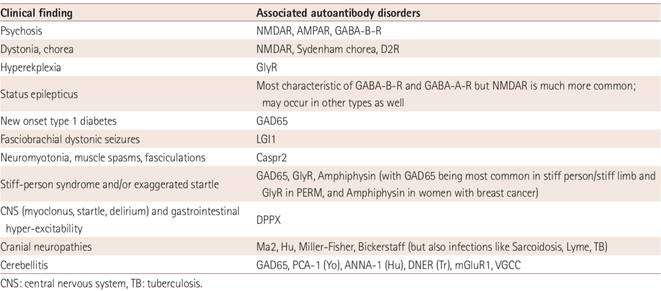Autoimmune encephalitis
Auto-immune encephalitis involves multiple diseases with different pathophysiology, including paraneoplastic syndromes (associated with antibodies to intracellular antigens, such as anti-Hu, discussed elsewhere on this website) and a group of diseases associated with autoantibodies to extracellular epitopes of ion channels, receptors and other associated proteins, such as the NMDA receptor.
Presentation of autoimmune encephalitis:
- Subacute (days to weeks) progressive decrease in consciousness, often with fluctuations and altered cognition.
- Seizures
- Memory, especially retention of new information, may be impaired early in the clinical course.
- Psychiatric symptoms (psychosis, aggression, inappropriate sexual behavior, panic attacks, compulsive behavior, euphoria, or fear)
- Abnormal movements or dystonia may be the presenting symptom
Autoimmune encephalitis mimics/differential diagnosis:
- acute demyelinating encephalomyelitis (ADEM): (characteristic brain lesions, and sometimes involvement of the optic nerves or spinal cord
- Multiple sclerosis: generally easier to distinguish from autoimmune encephalitis due to more focal symptoms and characteristic brain imaging findings
- neuropsychiatric lupus (psychosis, seizures, vasculitis)
- Vasculitis affecting the CNS may rarely present with symptoms resembling encephalitis
- Bickerstaff encephalitis and Miller Fisher syndrome (loss of reflexes, GQ1b antibodies)
- Neuroleptic malignant syndrome
- Wernicke’s encephalopathy/Thiamine deficiency
- Lymphoma or carcinomatous meningitis
- Hashimoto’s encephalopathy
Infectious causes of encephalitis:
- HSV, VZV, CMV, EBV, JE, enterovirus, HHV6 (transplant patients), HHV7
- Neuroborreliosis, Syphilis
- West Nile virus
- Cryptococcus, Aspergillus Fumigatus, Mucor
- Tuberculosis, toxoplasmosis
- Streptococcus, listeria
- Rare causes: leptospirosis, neurotropic astrovirus infection, Balamuthia mandrillaris, and squirrel bornavirus.
Clinical findings associated with autoantibody disorders
Paraneoplastic antibodies
- Anti-Hu (previously called antineuronal nuclear antibody 1 or ANNA-1) is an autoantibody detected in the serum of patients with paraneoplastic subacute sensory neuronopathy and/or encephalomyelitis
- Anti-Ri (previously called antineuronal nuclear antibody 2 or ANNA-2) may be present in patients with opsoclonus/myoclonus syndrome
- Antibodies directed against amphiphysin (a synaptic vesicle protein) have been detected in the serum of patients with the paraneoplastic form of stiff man syndrome [47]
- The antineuronal antibodies Ma1 and Ma2 (also called anti-Ta) are members of a novel but expanding family of brain-specific or testis-specific proteins; while Ma1 is not found in association with any one type of tumor, Ma2 seems to be associated strongly with testicular cancer
- The anti-Yo or anti-Purkinje cell antibody 1 (APCA-1) has been detected in patients with paraneoplastic cerebellar degeneration

